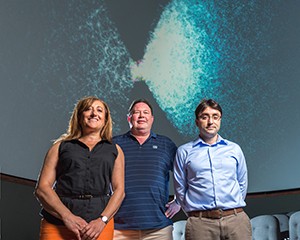Oct 30 2015
University of Notre Dame astronomer Timothy Beers and his Galactic Archaeology group, which includes Notre Dame astronomers Daniela Carollo and Vinicius Placco, have led an international team of researchers that produced the first chronographic (age) map of the halo of the Milky Way galaxy. The halo, along with the disk and bulge, are the primary components of the galaxy.
 Daniela Carollo, left, Timothy Beers and Vinicius Placco. Credit: University of Notre Dame
Daniela Carollo, left, Timothy Beers and Vinicius Placco. Credit: University of Notre Dame
Using a sample of 4,700 blue horizontal-branch (BHB) stars from the Sloan Digital Sky Survey, the research team showed that the oldest stars are concentrated in the central region of the galaxy, confirming predictions from numerical simulations of galaxy assembly. The researchers have also shown that chronographic maps such as theirs can also be used to identify complex structures of stars still in the process of being added to the halo system of our galaxy.
Daniela Carollo, left, Timothy Beers and Vinicius Placco Daniela Carollo, left, Timothy Beers and Vinicius Placco
The researchers used the colors of BHB stars, which burn helium in their cores, to produce the age map. The technique relies on the fact that the colors of BHB stars are related to their masses, which in turn are related to their ages. The research results allowed the team, for the first time, to demonstrate two primary results.
“The oldest stars in the galaxy are concentrated toward the center of the galaxy, as predicted by previous numerical simulations of the assembly of our Milky Way,” Beers said. “Surprisingly, the region of the oldest stars extends all the way to the halo region close to the sun. This Ancient Chronographic Sphere can now be explored in order to study the properties of these old stars, which will tell us about the chemistry of the early universe.”
The researchers have also resolved the ages of dwarf galaxies and their stellar debris, which was stripped from them due to their gravitational interaction with the Milky Way.
“This information can be used to tell us the assembly history of our galaxy,” Beers said. “We can now search for additional debris streams in the halo of the galaxy, based on their contrast in age, rather than simply their density contrast.”
This chronographic map of the Milky Way's halo system shows a color gradient that is associated with an age difference of roughly 2-2.5 G yrs. The oldest stars are the darkest and are concentrated in the central part of the galaxy, the darkest portion of the bottom of the map This chronographic map of the Milky Way’s halo system shows a color gradient that is associated with an age difference of roughly 2-2.5 G yrs.
According to Beers, “It is almost like having X-ray vision, as we can see through the numerous foreground stars and not be confused by the equally large numbers of background stars.”
The researchers used stars with spectroscopy collected during the Sloan Digital Sky Survey, and from that, they determined the parameters that allow them to efficiently separate the BHB stars from other kinds of stars. From that, a relatively pure sample could be obtained, enabling a clear age map to be made based on their colors.
The results extend and refine some prevailing assumptions in astrophysics.
“We have confirmed one prediction, that the oldest stars, born shortly after the Big Bang, should be found near the center of the galaxy, and demonstrated in addition that searches for ancient stars in the region of the halo close to the solar neighborhood will be highly effective,” Beers said. “The assembly history of the galaxy, which is encoded in the ages of the members of the halo population, is now a story that can be explored and told more fully.”
Beers’ Galactic Archaeology group at Notre Dame is now preparing a much more extensive age map of the galactic halo based on hundreds of thousands of BHB stars, also from the Sloan survey. The group’s next detailed map will serve as a guide for astronomers to identify numerous new dwarf galaxy debris signatures and enable the development of a refined history of the assembly of the Milky Way.
Astronomers will also use their new technique to study additional large samples of BHB stars collected through other sky surveys now being carried out, as well as in the near future with the Large Synoptic Survey Telescope (LSST), presently under construction in Chile. According to Beers, “Eventually, the LSST will obtain samples of millions of BHB stars, all the way to the edge of the galaxy, which will also be studied using our approach.”